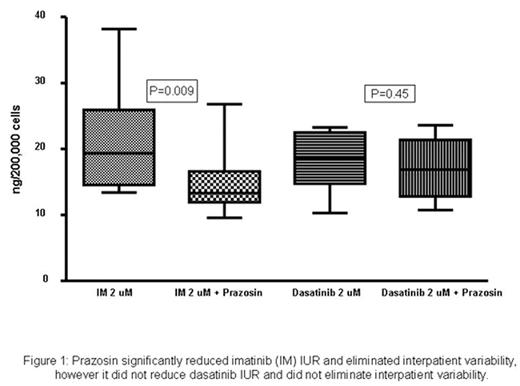Abstract
Molecular response to imatinib in newly diagnosed CML patients correlates with intrinsic sensitivity to imatinib (IC50imatinib) which is related to imatinib intracellular uptake and retention (IUR). Imatinib cellular uptake is OCT-1 dependent and low OCT-1 activity in newly diagnosed CML patients is a major contributor to suboptimal response to imatinib. The cellular transport pathways for dasatinib, a more potent BCR-ABL kinase inhibitor, are yet to be defined. We have assessed dasatinib cellular transport pathways using mononuclear cells (MNCs) from newly diagnosed CML patients and cell lines. Dasatinib IUR was determined with 14C-labelled dasatinib (Bristol-Myers Squibb) at 4°C and 37°C, with/without influx/efflux inhibitors. There was no significant difference in dasatinib IUR at 37°C and 4°C in KU812 cell line (27 ng vs. 26 ng) and MNCs of CML patients (17 ng vs. 17 ng, n=10), indicating cellular uptake was not temperature dependent and most likely passive. Prazosin and progesterone (OCT-1 and OCT-3 inhibitors) did not significantly reduce IUR and did not reduce inter-patient variation in dasatinib IUR in contrast to imatinib IUR (P=0.45 and P=0.93 respectively, Fig. 1). Procainamide (OCT-1 and OCT-2 inhibitor), nicotinamide (OCT-2) and corticosterone (OCT-3 inhibitor) reduced dasatinib IUR but this did not reach significance (P=0.42, 0.74, 0.79 respectively). These data suggest that dasatinib uptake is not OCT dependent. Using ABCB1 overexpressing cell lines, we found that dasatinib IUR is lower in K562-Dox (P<0.001) and VBL-100 (P=0.05) compared to parental cell lines (K562 and CCRF-CEM respectively). PSC-833 (ABCB1 inhibitor, Novartis) significantly increased dasatinib IUR (P<0.0001), reduced IC50dasatinib in K562-Dox cell line (100 nM vs. 16 nM) and increased IUR in VBL-100 (P=0.01) suggesting ABCB1 actively efflux dasatinib. Median IC50dasatinib in 18 newly diagnosed CML patients was 2.20 nM (± 0.8), which is significantly below median plasma concentration achieved (100–200 nM). Interpatient variability in IC50dasatinib and IUR is therefore unlikely to be clinically significant for newly diagnosed CML patients receiving dasatinib. In conclusion
dasatinib cellular uptake is predominantly passive and may be OCT independent.
dasatinib is effluxed actively by ABCB1 in cell lines over-expressing these proteins.
Inter-patient variation in dasatinib intracellular uptake and intrinsic sensitivity may not be clinically significant in newly diagnosed CML patients receiving dasatinib, in contrast to recipients of imatinib.
Prazosin significantly reduced imatinib (IM) IUR and eliminated interpatient variability, however it did not reduce dasatinib IUR and did not eliminate interpatient variability.
Prazosin significantly reduced imatinib (IM) IUR and eliminated interpatient variability, however it did not reduce dasatinib IUR and did not eliminate interpatient variability.
Author notes
Disclosure:Research Funding: Research funding from Bristol Myers Squibb and Novartis. Honoraria Information: Honoraria from Bristol-Myers Squibb and Novartis.


This feature is available to Subscribers Only
Sign In or Create an Account Close Modal